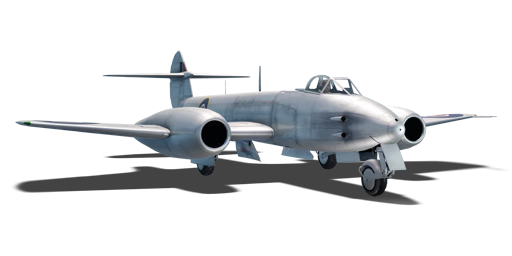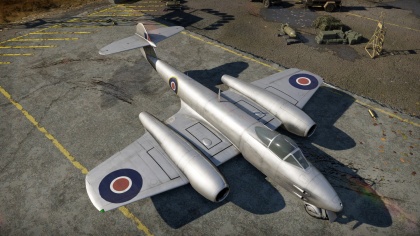Difference between revisions of "Meteor F Mk 4 G.41G"
(→General info: Updated table designs) |
(→Modules) (Tag: Visual edit) |
||
| Line 83: | Line 83: | ||
|- | |- | ||
! colspan="3" | Engine characteristics | ! colspan="3" | Engine characteristics | ||
| − | ! colspan="3" | Mass with fuel (no weapons load) || rowspan="2" | Max Takeoff<br/>Weight | + | ! colspan="3" | Mass with fuel (no weapons load) || rowspan="2" | Max Takeoff<br />Weight |
|- | |- | ||
! Weight (each) || colspan="2" | Type | ! Weight (each) || colspan="2" | Type | ||
| Line 100: | Line 100: | ||
| 0.54 || 0.49 || 0.47 || 0.46 | | 0.54 || 0.49 || 0.47 || 0.46 | ||
|- | |- | ||
| − | | ''Optimal'' || 1,587 kgf<br/>(0 km/h) || N/A | + | | ''Optimal'' || 1,587 kgf<br />(0 km/h) || N/A |
| 0.54 || 0.49 || 0.47 || 0.46 | | 0.54 || 0.49 || 0.47 || 0.46 | ||
|- | |- | ||
| Line 107: | Line 107: | ||
=== Survivability and armour === | === Survivability and armour === | ||
<!--''Examine the survivability of the aircraft. Note how vulnerable the structure is and how secure the pilot is, whether the fuel tanks are armoured. Describe the armour, if there is any, also mention the vulnerability of other critical aircraft systems.''--> | <!--''Examine the survivability of the aircraft. Note how vulnerable the structure is and how secure the pilot is, whether the fuel tanks are armoured. Describe the armour, if there is any, also mention the vulnerability of other critical aircraft systems.''--> | ||
| + | |||
* 38 mm Bulletproof glass in cockpit front. | * 38 mm Bulletproof glass in cockpit front. | ||
* 12.7 mm Steel plate behind the pilot. | * 12.7 mm Steel plate behind the pilot. | ||
| Line 119: | Line 120: | ||
The '''''{{PAGENAME}}''''' is armed with: | The '''''{{PAGENAME}}''''' is armed with: | ||
| + | |||
* 4 x 20 mm Hispano Mk.V cannon, nose-mounted (200 rpg top, 190 rpg bottom = 780 total) | * 4 x 20 mm Hispano Mk.V cannon, nose-mounted (200 rpg top, 190 rpg bottom = 780 total) | ||
| Line 140: | Line 142: | ||
| I | | I | ||
| Fuselage Repair | | Fuselage Repair | ||
| − | + | | | |
| − | | | ||
| | | | ||
| + | |Offensive 20 mm | ||
|- | |- | ||
| II | | II | ||
| Line 154: | Line 156: | ||
| Engine | | Engine | ||
| | | | ||
| − | | | + | |New 20 mm cannons |
|- | |- | ||
| IV | | IV | ||
| − | | | + | |G-suit |
| − | | | + | | |
| Cover | | Cover | ||
| | | | ||
| Line 177: | Line 179: | ||
'''Cons:''' | '''Cons:''' | ||
| + | |||
* Compression | * Compression | ||
* Loses manoeuvrability over 700 kph significantly | * Loses manoeuvrability over 700 kph significantly | ||
Revision as of 13:58, 15 August 2020
Contents
| This page is about the British jet fighter Meteor F Mk 4 G.41G. For other uses, see Meteor (Family). |
Description
The Meteor F Mk 4 type G.41G is a rank V British jet fighter
with a battle rating of 7.7 (AB) and 8.0 (RB/SB). This aircraft has been in the game during the Open Beta Test prior to Update 1.29.
General info
Flight Performance
| Characteristics | Max Speed (km/h at 100 m) |
Max altitude (metres) |
Turn time (seconds) |
Rate of climb (metres/second) |
Take-off run (metres) | |||
|---|---|---|---|---|---|---|---|---|
| AB | RB | AB | RB | AB | RB | |||
| Stock | 920 | 897 | 12500 | 24.1 | 24.7 | 33.6 | 31.7 | 325 |
| Upgraded | ??? | ??? | ??.? | ??.? | ??.? | ??.? | ||
Details
| Features | |||||
|---|---|---|---|---|---|
| Combat flaps | Take-off flaps | Landing flaps | Air brakes | Arrestor gear | Drogue chute |
| ✓ | ✓ | ✓ | ✓ | X | X |
| Limits | ||||||
|---|---|---|---|---|---|---|
| Wings (km/h) | Gear (km/h) | Flaps (km/h) | Max Static G | |||
| Combat | Take-off | Landing | + | - | ||
| 0 | 390 | 520 | 520 | 290 | ~10 | ~5 |
| Optimal velocities (km/h) | |||
|---|---|---|---|
| Ailerons | Rudder | Elevators | Radiator |
| < 560 | < 600 | < 580 | N/A |
Engine performance
| Engine | Aircraft mass | |||||
|---|---|---|---|---|---|---|
| Engine name | Number | Empty mass | Wing loading (full fuel) | |||
| Rolls-Royce Derwent 5 | 2 | 5,516 kg | 207 kg/m2 | |||
| Engine characteristics | Mass with fuel (no weapons load) | Max Takeoff Weight | ||||
| Weight (each) | Type | 7m fuel | 20m fuel | 24m fuel | ||
| 443 kg | Centrifugal-flow turbojet | 5,888 kg | 6,539 kg | 6,739 kg | 6,940 kg | |
| Maximum engine thrust @ 0 m (RB / SB) | Thrust to weight ratio @ 0 m (100%) | |||||
| Condition | 100% | WEP | 7m fuel | 20m fuel | 24m fuel | MTOW |
| Stationary | 1,587 kgf | N/A | 0.54 | 0.49 | 0.47 | 0.46 |
| Optimal | 1,587 kgf (0 km/h) |
N/A | 0.54 | 0.49 | 0.47 | 0.46 |
Survivability and armour
- 38 mm Bulletproof glass in cockpit front.
- 12.7 mm Steel plate behind the pilot.
- 12.7 mm Steel plate in the nose.
- Critical components located at the front and wings of aircraft (fuel, pilot, engine, controls
Armaments
Offensive armament
The Meteor F Mk 4 G.41G is armed with:
- 4 x 20 mm Hispano Mk.V cannon, nose-mounted (200 rpg top, 190 rpg bottom = 780 total)
Usage in the battles
Modules
| Tier | Flight performance | Survivability | Weaponry | ||
|---|---|---|---|---|---|
| I | Fuselage Repair | Offensive 20 mm | |||
| II | Compressor | Airframe | |||
| III | Wings Repair | Engine | New 20 mm cannons | ||
| IV | G-suit | Cover | |||
Pros and cons
Pros:
- Good acceleration.
- High top speed for an 8.0 jet
- Clipped wings offer an improvement over the previous model in energy retention and wing durability
- Good at turning below 650 kph
- Good climb rate
- Excellent ammo capacity for cannons (190 RPG for two of the cannons, 200 RPG for the other two.)
Cons:
- Compression
- Loses manoeuvrability over 700 kph significantly
- Limited visibility out of the rear of the cockpit
History
In 1946 the Gloster Meteor F.Mk.4 was introduced; a variant intended to replace the F.Mk.3. The prototype F.Mk.4 flew for the first time on May 17th 1945; the new variant was powered by Rolls-Royce Derwent Mk.5 turbojet engines, producing 1,590 kg of thrust (more than twice as much as the Derwent Mk.1). The engines were fitted in new extended nacelles, which reduced drag, and a strengthened airframe design was incorporated to harness the increased power. Fitted with the new engines, the Meteor F.Mk.4 would go on to set two world air speed records in November 1945 and then again in September 1946.
Further modifications to the Meteor F.Mk.4 included its ailerons and adjustments to its rudder trim tab to reduce snaking. The cockpit was now fully pressurized and ventilated; previous versions of the Meteor had had a non-pressurized cockpit.
Trials of the prototype Gloster Meteor F.Mk.4 fighter showed that its maximum speed was increased by 180 km/h, but that this additional speed produced excessive stress on the wings. The wing panels, therefore, were made shorter from the ninth production aircraft onwards. This reduced the stress and improved horizontal manoeuvrability but reduced the rate of climb and the service ceiling. Type G.41F became the designation for the long-wing aircraft, and Type G.41G for the short-wing variant.
The Gloster Meteor F.Mk.4 represented a significant leap in terms of performance and was produced in large numbers, including as an export fighter. Based on the F.Mk.4, the two-seat T.Mk.7 trainer was developed.
By 1948 the F.Mk.4 had completely replaced the F.Mk.3 in the RAF and In May 1947, an export version was purchased by Argentina, followed by orders from Denmark, Egypt, Belgium and the Netherlands.
535 Gloster Meteor F.Mk.4 were produced for the RAF, with a further 168 aircraft being exported.
Media
An excellent addition to the article will be video guides, as well as screenshots from the game and photos.
Read also
Links to the articles on the War Thunder Wiki that you think will be useful for the reader, for example,
- reference to the series of the aircraft;
- links to approximate analogues of other nations and research trees.
Sources
Paste links to sources and external resources, such as:
- topic on the official game forum;
- page on aircraft encyclopedia;
- other literature.
| Gloster Aircraft Company, Limited | |
|---|---|
| Fighters | Gladiator Mk II · Sea Gladiator Mk I · Gladiator Mk IIF · Gladiator Mk IIS · Tuck's Gladiator Mk II |
| Jet Fighters | Meteor F Mk 3 · Sea Meteor F Mk 3 · Meteor F Mk 4 G.41F · Meteor F Mk 4 G.41G · Meteor F Mk 8 G.41K · Meteor F Mk.8 Reaper |
| Javelin F.(A.W.) Mk.9 | |
| Export | J8A · Iacobi's J8A · ␗Gladiator Mk I · ▄Gladiator Mk I |
| ▄Meteor F Mk.8 · Meteor F.8 · Meteor NF.13 | |
| See Also | Fokker |
| Britain jet aircraft | |
|---|---|
| Blackburn | Buccaneer S.1 · Buccaneer S.2 · Buccaneer S.2B |
| British Aerospace | Harrier GR.7 · Sea Harrier FRS.1 (e) · Sea Harrier FRS.1 · Sea Harrier FA 2 |
| British Aircraft Corporation | Strikemaster Mk.88 |
| English Electric | Canberra B Mk 2 · Canberra B (I) Mk 6 · Lightning F.6 · Lightning F.53 |
| Gloster | Meteor F Mk 3 · Sea Meteor F Mk 3 · Meteor F Mk 4 G.41F · Meteor F Mk 4 G.41G · Meteor F Mk 8 G.41K · Meteor F Mk.8 Reaper |
| Javelin F.(A.W.) Mk.9 | |
| de Havilland | Vampire F.B.5 · Venom FB.4 · Sea Venom FAW 20 · Sea Vixen F.A.W. Mk.2 |
| Hawker | Sea Hawk FGA.6 · Hunter F.1 · Hunter F.6 · Hunter FGA.9 · Harrier GR.1 · Harrier GR.3 |
| Panavia | Tornado GR.1 · Tornado GR.4 · Tornado F.3 · Tornado F.3 Late |
| SEPECAT | Jaguar GR.1 · Jaguar GR.1A · Jaguar IS |
| Supermarine | Attacker FB 1 · Attacker FB.2 · Scimitar F Mk.1 · Swift F.1 · Swift F.7 |
| Foreign | Phantom FG.1 (USA) · Phantom FGR.2 (USA) · F-4J(UK) Phantom II (USA) |
| Australia | F-111C |
| India | ▄MiG-21 Bison |
| South Africa | ▄JAS39C |





